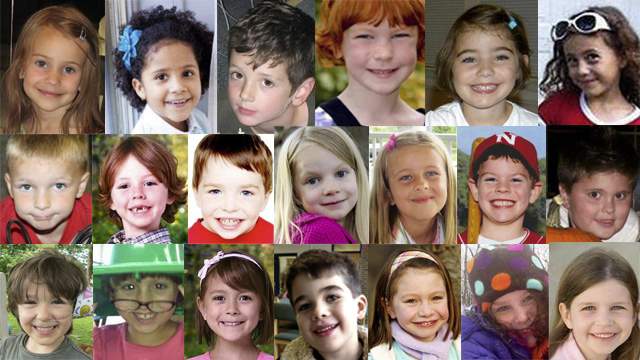Op Ed: The children in our backyard

“Do you know Donald Trump?” asked Fergal, the seven-year-old boy who had magically appeared right next to me, just as we sat down at our dinner table.
“Donald Trump? He’s my uncle. Do you know him?” I said, unable to resist a chance at child-play. He quickly turned and ran back to his parents’ table, as I thought, regrettably, “I guess I scared him off.” But then he was back and forth, again and again. It was all a delightful prelude to our two nights at Gougane Barra, a deeply spiritual place we are thankful not to have missed. Fergal’s large, round eyes and open expression instantly reminded me of the faces of 20 American children in a photo I had used in a public lecture a few weeks earlier. He could have been the boy in the bottom row, centre.

Even against the backdrop of America’s difficult election season, my time and work in Ireland is one of the best experiences of my life. In May, when I was in Peru, and now here in Ireland, everyone wants to understand Donald Trump, the Republican nominee for President of the United States. I wish I could explain him or his “policies.” When I introduced myself at a college-wide faculty meeting, I said, “Right now, Americans anywhere in the world have to introduce themselves as, “Not Donald Trump.”
While it’s hard to grasp in our current election throes, these games are dwarfed beside the issue that matters most--gun violence. According to the BBC (citing the Gun Violence Archive), at least “13,286 people were killed in the US by firearms in 2015 . . . and 26,819 people were injured [those figures exclude suicide].” Citing the United Nations Office on Drugs and Crime, the BBC further states that, “Of all the murders in the US in 2012, 60% were by firearm compared with . . . just 10% in the UK.” For decades, America has been adrift in an endless sea of words, images, laws, policies, and events that add up to a single phrase: all guns, all the time.
You will find an endless march of sad statistics about the frequency of American gun violence. You will also find conclusions from professional organisations, such as the American Academy of Paediatrics, which summarises research linking aggression and violent behavior (209). As well, the Media Violence Commission of the International Society for Research on Aggression concluded that, “Over the past 50 years, a large number of studies conducted around the world have shown that watching violent television, watching violent films, or playing violent video games increases the likelihood of aggressive behaviour” (2012). Such arguments, however, are rooted in rationality, logic, science, and an affinity for humane values, none of which seem to matter these days.
The result is that guns creep into Americans’ daily lives, including those of us who believe gun-love is nourished by (among many other sources) deep streaks of paranoia and cowardice. Weapons even nudge into quiet lives like mine. I live in a small city in the middle of a state in the middle of America, a university town, 120 miles from any urban centre. Last spring I went to Walmart to buy a fishing license. A middle-aged man came up to the counter beside me and told the young sales clerk he wanted “100 rounds for his .38 pistol.” Just what are the possible uses of this small handgun? And why would anyone want 100 rounds of ammunition? The man then added, “I need to be ready for when Obama comes for our guns.” None of this seemed to register with the young woman behind the counter, but I merely heard a very frequently repeated line, a cliché. As I left the store, I realised that filmmaker Roger Moore’s suggestion that bullets be highly taxed makes a lot of sense. A whole lot of sense.
If gun-love doesn’t seek you out in the acreage of Middle America, it will assault you on the Internet, including those times when you’re trying to make a simple purchase. For several years I had ordered leather items online from a company that made excellent products. One day, I received an email from this company that was celebrating the film created by one of its employees. This company was evidently proud to have such “creative” employees and this short film had been accepted into a film festival. I was curious, so clicked on the link to view the brief film. It was about a married couple who did everything together, including carrying matching pistols. I’m not sure, but I think that their look-alike weapons were supposed to be “cute.”
The film ended with husband and wife pointing their twin firearms directly at the camera and firing. I wrote to this company, telling them that I did not find a single crumb of “creativity” in their film, nor did I understand why or how a maker of briefcases and wallets would shove such idiocy down their customers’ virtual throats. They wrote back several defenses of their advocacy of gun-love, but I told them that I would never again buy their products.
America, the land of sacred free speech, does not censor very much material. The most censored photos of the past 100 years are those that were never made public—those of the 20 children and three teachers murdered at the elementary school in Newtown, Connecticut. Only a few people have called for these photos to be released, because of the utter horror these images would of course wreak upon the parents, friends, and relatives of these children, some of whom had been shot 11 times. Because nothing else has worked to reduce gun violence, I believe that releasing these photos can help us face what we have collectively done and continue to tacitly approve.
America cannot begin to step toward human values, we cannot hope to mend ourselves, until we face, directly, what we continue to allow--the wholesale slaughter of children. Look again at the faces of these child-victims. They are babies. Fergal, the gregarious boy who sprouted at my table, will have a much greater chance to grow up safely in Ireland, than he would if he lived in the USA. Children anywhere, though, are children everywhere. Killing our young is the most heinous of evils, including allowing it to happen. Trump, himself, is not the issue. Rather, it’s his message, forged in a seething hatred. As it cools in the air, it forms into a definite shape, and hence gains a kind of legitimacy. At the same time, this “voice” distracts and obscures America’s central issue: the largely unfettered freedom to kill.
This many decades and this much destruction later, America still cannot find those weapons of mass destruction—not even in our own backyard pile of bullet-riddled children.
US academic Dr Roy Fox from the University of Missouri is a Fulbright Scholar at UCC where he is leading a series of workshops for staff and graduate students as they develop scholarly and creative projects.
For media queries contact Ruth Mc Donnell, Head of Media and PR, Office of Marketing and Communications, UCC Mob: 086-0468950
